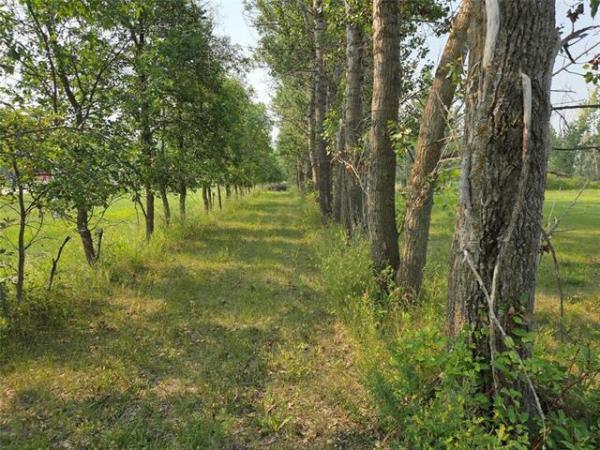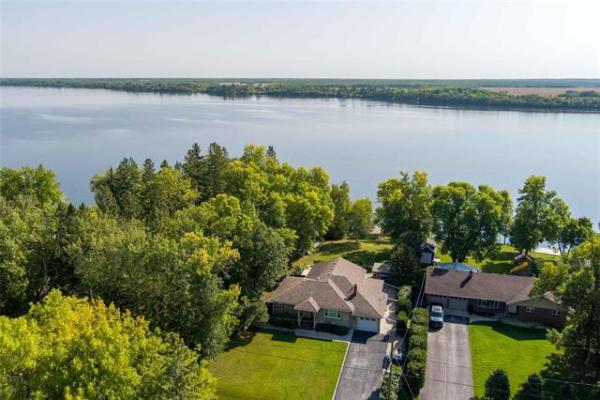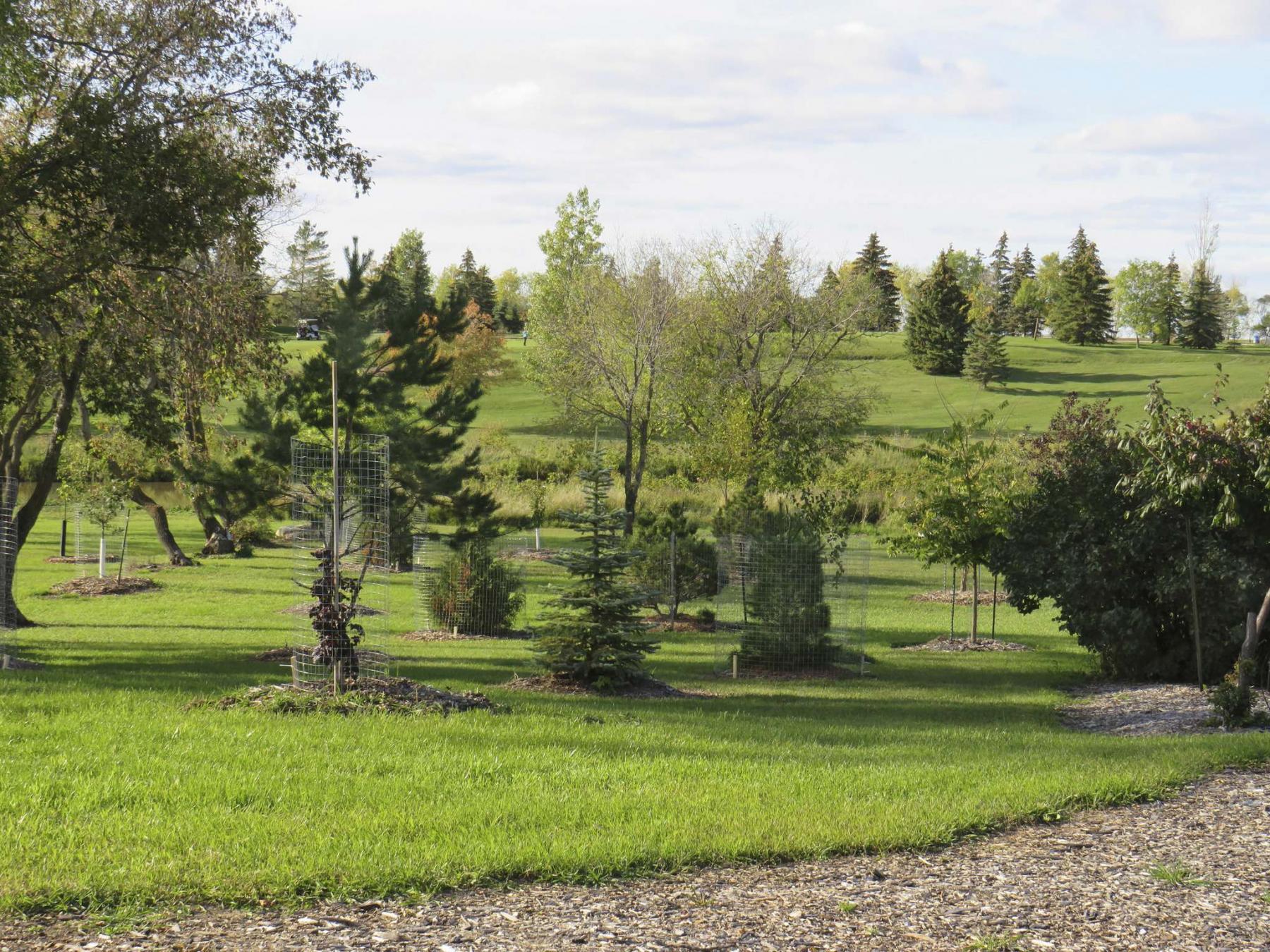
A mulched pathway winds through newly planted trees that will be a future tree canopy.
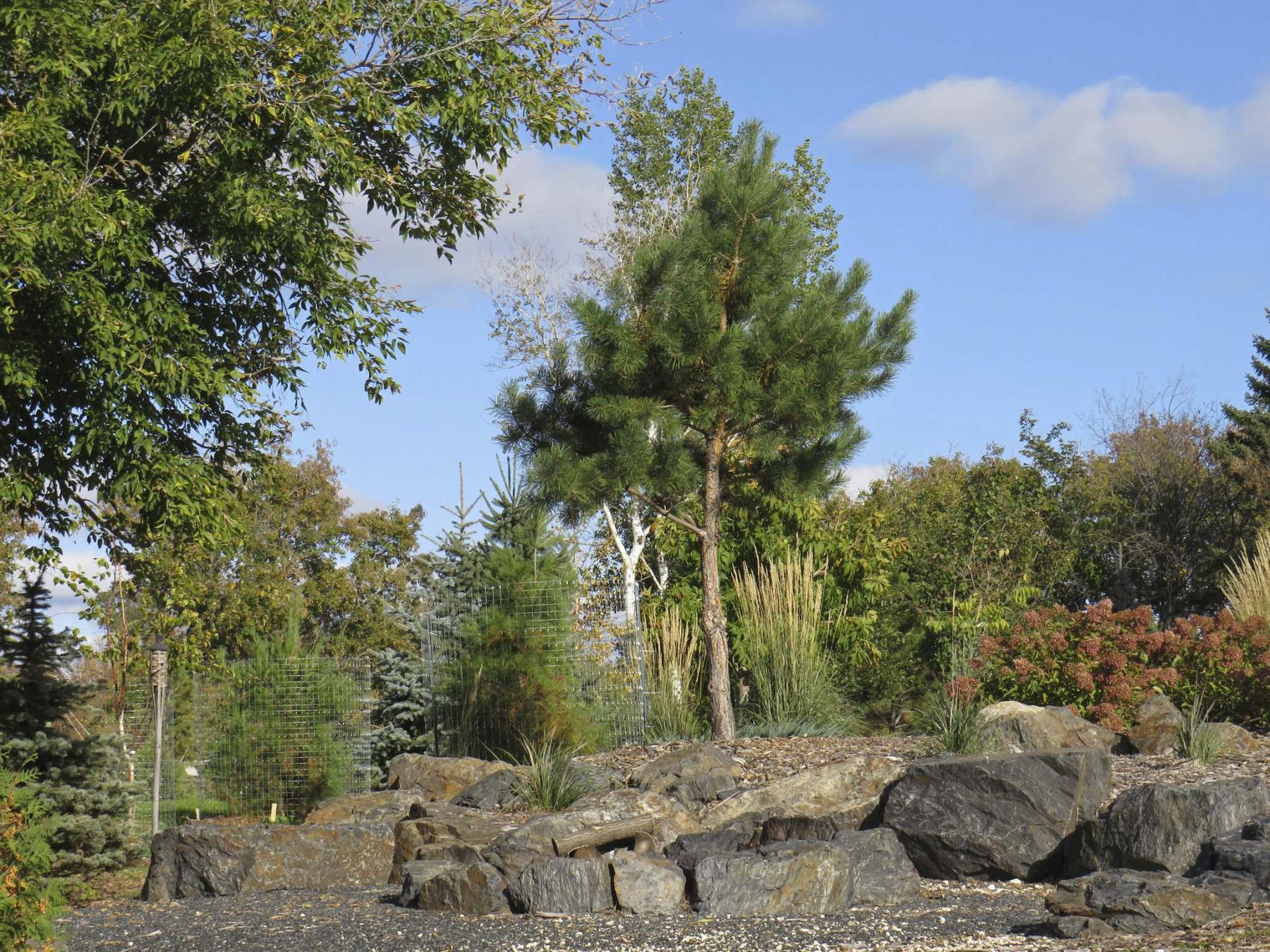
Trees can recover from damage by wildlife but cages serve as protection too.
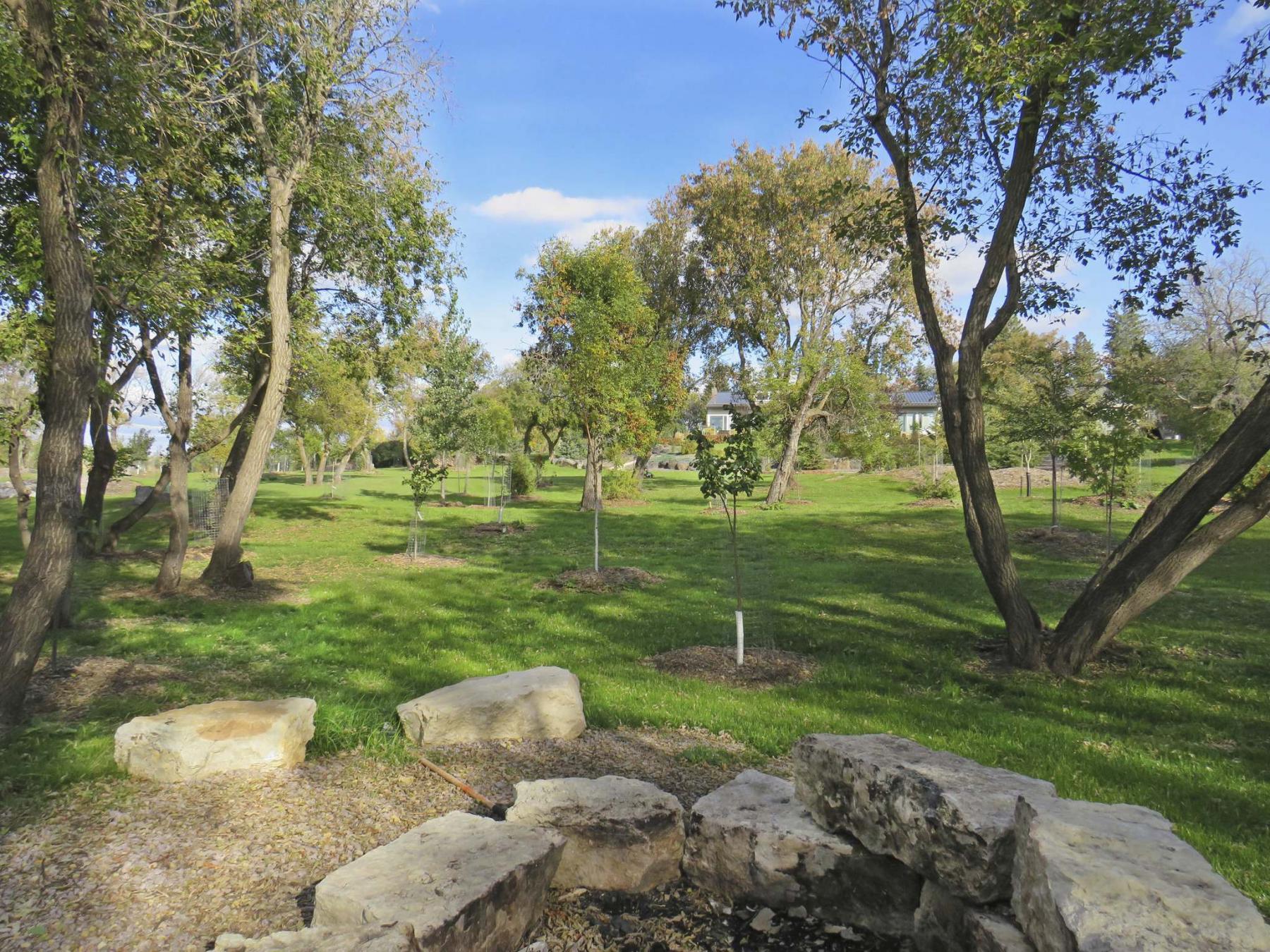
Let the view from your house influence which types of trees to plant and where to plant.
If it’s Darren Murphy reading the signs, choosing the right trees for his property is about much more than just good looks, especially when he’s already in a challenging situation.
Murphy’s picturesque property is located adjacent to the Kingswood golf course in La Salle, 10 kilometres south of Winnipeg’s perimeter highway. The La Salle river flows by on the north and west side adding to his property’s striking views. In recent years, Murphy has planted 80 different species of trees, more than 500 trees in all. He knows every one of his trees: their growth rate, mature height and width, preferred soil type (moist, drought-tolerant or well-drained), and sun exposure. He has carefully researched and selected each variety for attributes such as aesthetics, hardiness and longevity and in some cases, depending on where a tree would be situated, for flood tolerance.
Viewed from a vantage point across the La Salle river, it’s clear to the observer that much more is happening on Murphy’s expansive property than one man’s greening initiative that has seen a vast number of trees planted in the space of about five years. Murphy’s long-term vision and plan can be seen in this thoughtfully designed gorgeous landscape but so, too, in the strong defences that he has built along the northern edge of his property. Murphy’s personal law dictates that if anything can go wrong it will go wrong along the northern edge where chunks of ice accumulated at the La Salle bridge in years when river levels were abnormally high. Large chunks of ice that dislodge from ice jams have the capacity to cause significant damage to trees. Murphy is ready for anything.
To protect the trees in the riparian area of his property, Murphy has built massive berms high above the flood plain level. "It was a lot of work," says Murphy who brought in hundreds of tandem loads of soil. To stabilize the berms and blunt any potential impact of ice, huge limestone boulders have been placed on both sides of the berms.
With a much higher elevation in the riparian area of his property, Murphy’s next task was to research tree species with tolerance to saturated soil and intermittent flooding. Many tree varieties prefer ideal conditions — adequate moisture, good soil drainage, partial to full sun — and can suffer damage such as defoliation, crown dieback, leaf chlorosis or even death as a result of flooding. Two good resources include A Field Guide to the Native Trees of Manitoba and the North Dakota State University extension service.
There are already several mature Acer negundo Boxelder maple trees that dot Murphy’s property. Boxelder is often found growing on floodplains. Murphy also selected deciduous tree species such as cottonwood, Golden Weeping willow, Prairie Cascade weeping willow, Delta Hackberry, Silver Maple, Bur oak and Freeman maple varieties such as Autumn Blaze – all of which have varying tolerance of flood saturated soils. Murphy has also planted several Black Hills White Spruce (Picea glauca Densata), a magnificent conifer with a mature height of 13 metres.
Further into the property where there is more protection from the elements, several Balsam fir trees, Northern White and Eastern White cedars, tamaracks, Medora juniper, Skybound cedar, Western Red cedar, and Ponderosa pine trees provide year-round colour as well as privacy. The most scintillating colour is provided by Crystal Blue Spruce, said by some to be the best and toughest blue spruce variety for Manitoba. It is a sunburn resistant variety and has exceptional steel blue needle colour that is a standout in the landscape.
Murphy plants for seasonal colour year-round: blues and greens in winter, pink and white blossoms in spring followed by showy fruit, summer foliage in shades of green or purple, and a kaleidoscope of fall colour. There are intriguing varieties such as Ohio Buckeye with its large compound leaves and curious prickly fruits, exotic Black Locust tree with fragrant white flowers in spring, Prairie Splendor Norway Maple with rich purple foliage throughout the summer, Night Rider elm with rich, unexpected purple fall colour, and glorious sugar maple varieties such as Unity which has five-lobed foliage and Inferno with its exceptional orange-red fall colour.
Murphy has planted for diversity and privacy but his preferences for specific shapes, textures, and seasonal colour have also been influenced by the views from his house and throughout different areas of his multi-acre property.
Murphy has also planted a fruit orchard which is nestled in an area bordered by a tall hedge of lilacs. Fruit tree varieties include plum, apricot, apple, pear and cherry as well as haskap, saskatoon, and raspberry bushes. Murphy hopes that there is enough fruit for everyone — his family and visiting wildlife.
Murphy’s property can’t be described with just one word. It’s a fascinating combination of park-like beauty and open spaces but it’s also a living laboratory for Murphy to learn more about the resilience of a wide range of tree species to factors such as pressures from wildlife and climate. Murphy is welcoming to wildlife and takes steps to preserve the natural setting.
"Deer are beautiful animals to see and watch in your yard," says Murphy, "but they can be severely damaging to trees." In addition to natural browsing, deer rub their antlers against tree bark to remove the dried covering that forms on their antler.
Murphy protects his trees with cylindrical wire cages ensuring adequate space for trees to grow. Still, one inventive beaver figured out a way to lift one of the wire cylinders and extensively chewed branches and bark. Trees can survive the damage from wildlife depending on the extent but with the volume of wildlife that visit his property, Murphy leaves the wire cages in place and says that they don’t distract from his view from the house.
When Murphy purchased his property in 2013, he inherited numerous existing mature trees. In its previous life, Murphy’s property was a farm for about 100 years. Murphy, who grew up in La Salle and today is a pharmacist-owner commuting back and forth to Winnipeg daily, purchased the property in 2013. He inherited existing mature trees, mainly elm, boxelder maple, ash, and native species. Some of the oldest trees are nearing the end of their life and others have benefited greatly from being renovated gradually.
Fast forward into the distant future and someday the next owner will inherit the hundreds of trees that Murphy has planted, each one carefully nurtured and established in its formative years. But Murphy’s passion and vision is undoubtedly also a legacy for the townspeople of La Salle. The lush canopy combines to create an amazing forest of healthy trees, a haven for Murphy and his family as well as the diverse wildlife that visit regularly. It’s a visual reminder of how one person can make a positive impact for reforestation.
Winnipeggers who are concerned about losing older tree species on their private property may want to take a leaf out of Murphy’s book and start planting now. "When the older trees come down," says Murphy, "others can grow and fill the space so that you’re never without trees." Sounds like a plan.
colleenizacharias@gmail.com



